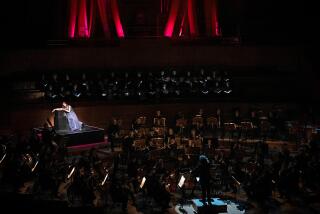Deciphering Sounds of a Celebrated Choreographer
- Share via
Tuesday night many members in the audience at Segerstrom Hall of the Orange County Performing Arts Center did what audiences very often tend to do when the Merce Cunningham Dance Company performs in a theater with a pit. During both intermissions and following the performance, they marched up to the stage and then peered down.
And who could blame them? The sounds that arise are, well, peculiar. Cunningham may be a greatly celebrated choreographer. Audiences the world over may readily recognize and cheer the virtuosity of the dancers and the inventiveness of the movement, whether they understand it or not. But very often the music simply bewilders--or worse.
Indeed, if Cunningham remains controversial, after more than half a century of work, I suspect that much of that controversy is because of the music. Sophisticated devotees of Cunningham’s dance have been known to bring their Walkmans to performances so that they could watch with their own music. I have overheard Cunningham company dancers say the most awful things about the music of the late music directors, John Cage and David Tudor, as well as about its current one, Takehisa Kosugi.
Yet Cunningham has a place reserved for him in the history of 20th century music, along with his obvious one in dance history. Cage, who first drafted Cunningham as a musician into his percussion ensemble in the late 1930s and then collaborated with Cunningham up until the composer’s death in 1992, turned the dance company into a workshop for the most radical experimental music. And those “experiments” by Cage and the many other composers Cage invited to write for the company over the years led to some of today’s common musical practices, from collage to ambient music to minimalism.
Just how vast a range of music that company has always supported can coincidentally be explored on an alluring CD, “Merce and Music,” released this week on the Catalyst label. Featuring music from the 1940s by Cage, Lou Harrison, Alexei Haieff and a ‘50s piece by Morton Feldman, it reveals a great spirit of musical openness--from bits of Americana to a sassy Cage using a phonograph recording as if it were a percussion instrument--that shows the Cunningham company not only on the musical cutting edge but also fearlessly floating into the musical mainstream. And who could be more mainstream a conductor than Jonathan Sheffer, who was responsible for the disc, since his other most recent release is conducting the soundtrack for “Michael Collins”?
Still there remain great misunderstandings about Cunningham and music. The main one is the idea that since the music and the choreography are made independently of each other, the music is therefore unimportant to the dance and consequently abstract, impersonal. But in the course of writing a biography of Cage, I have had occasion to ask Cunningham about music and about his relationship with composers. And invariably he offers a marvelous story about the personality of the composer.
Does Cunningham’s personal relationship with the composer then influence the dance? That will be something for future scholars to mull over. But it did seem that way Tuesday, and especially in Cunningham’s newest work, “Rondo,” which uses one of Cage’s last scores, “FOUR6.”
Cage created the score for a concert of his music given by soprano Joan La Barbara in Central Park in the summer of 1992, exactly three weeks before he died from a sudden massive stroke. Cage decided to write a special piece for La Barbara, the two musicians who were accompanying her (Los Angeles pianist Leonard Stein and Bay Area percussionist William Winant) and for the composer himself to perform. (The curious notation FOUR6means it is the sixth piece in a series of “number pieces” written for four performers.)
The score does not specify instruments and permits the performers to choose 12 different sounds and produce them within time perimeters. For his own part, Cage decided to rely on his voice and “shocking things.”
The night, however, was shocking all by itself. It was cold--it had rained all day and it was still misting and foggy by concert time. The audience was understandably small, with the central section of seats roped-off for a guest list, most of whom never showed. Cunningham and only a few others sat lonely in it. Cage’s “shocking things” were primarily strange vocal noises that blended eerily with the beautiful pitches La Barbara sang. (The performance was recorded live and has been issued on CD, “John Cage at Summerstage,” by the Music & Arts label.) It was Cage’s last performance, and those who knew Cage remember it with great emotion.
I was immediately transported back to that evening on watching “Rondo” Tuesday night. Perhaps it is just an audience member completing a work of art, as Cunningham, following Marcel Duchamp, says we must, but it was also hard not to sense the choreographer’s own deeply personal response to that evening. “Rondo” opens in foggy gloom, danced behind a scrim, the dancers dressed by Cunningham in typically motley rehearsal leotards.
But most interesting the music--a lively performance by Kosugi, by saxophonist Jon Gibson, trombonist Stuart Dempster and David Behrman using electronics (all, incidentally, are themselves composers of considerable note)--sounded absolutely nothing like it did in Central Park. The great innovation of Cunningham’s use of music is that he never pushes his response upon the listener. Indeed, what makes the music seem so personal is that he allows it also to be personal to the composers, the performers and the listeners. Everyone gets into act.
* The Merce Cunningham Dance Company performs repertory excerpts in a special full-evening event, Saturday at 8 in the Alex Theatre, 216 N. Brand Blvd., Glendale. Tickets: $22.50-$32.50. (800) 233-3123.
More to Read
The biggest entertainment stories
Get our big stories about Hollywood, film, television, music, arts, culture and more right in your inbox as soon as they publish.
You may occasionally receive promotional content from the Los Angeles Times.











